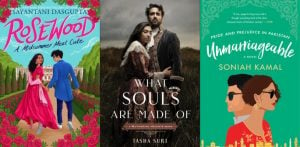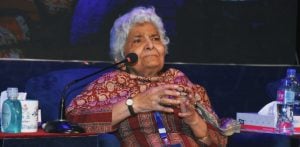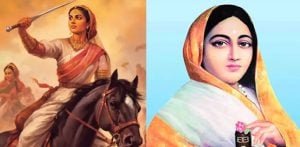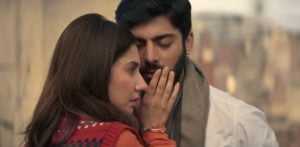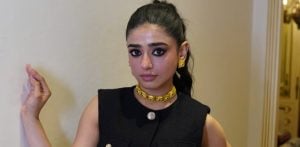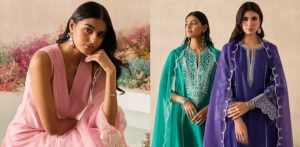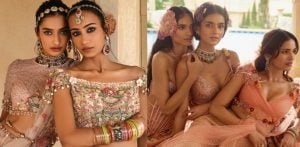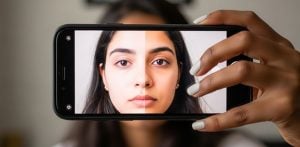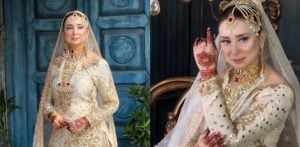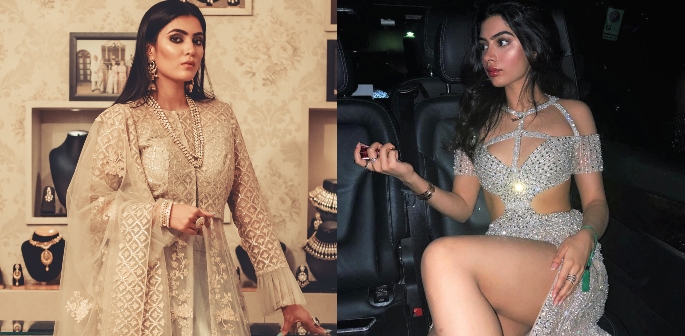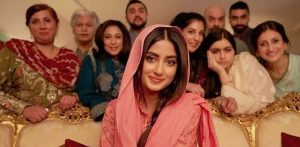"You can choose who can see your body and who can't."
As the fashion world continues to drive forward and evolve, the shift from modest to more revealing Desi fashion trends has also become more prevalent.
Hafsa Lodi, author of Modesty: A Fashion Paradox (2020), says modest fashion is:
“Deeply ingrained in our culture, where covering your skin is tantamount to maintaining your chastity and purity.
“Clothing that covers the skin is seen somewhat as a shield that protects you from the rumour-mongering community of aunties.”
Modest clothing has been the fashion stereotype for many South Asian countries and cultures. However, has that always been the case?
Saris, salwar kameez, kurtis are all staples of Desi fashion, which we still see today with modern improvements and evolving designs.
However, with western influences more prominent than ever, are Desi women now disregarding traditional wear for garments that showcase their style rather than their culture?
A Brief History of Fashion for Desi Women
Indian Fashion
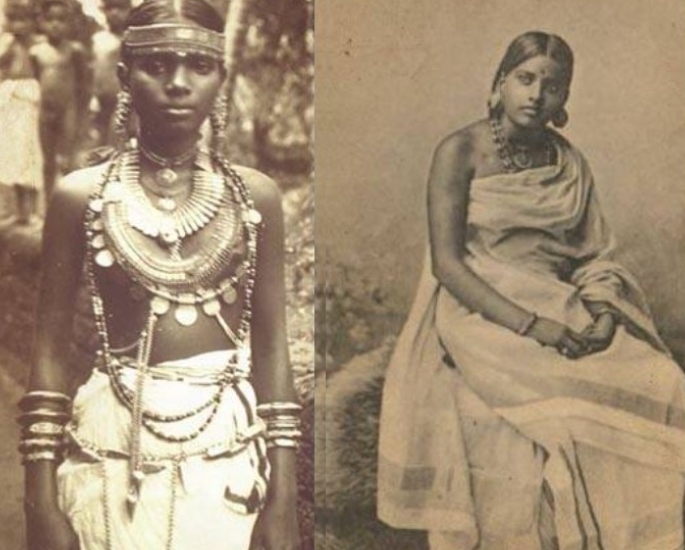
Desi women are no strangers to extravagant garments. Colourful embroidery, elegant drapes and sparkling accessories all fuse together creating spectacular ensembles.
Although traditional saris, salwars and lehengas have been the foundation of South Asian fashion for decades, has modesty always been a part of the Desi fashion trend?
Well in India, it seems that wasn’t the case.
The Vedic period between 1500 – 500 BCE saw Indian women wear a single piece of cloth that was wrapped around their body, similar to the fashion of Iranian and Greek women of the time.
In addition, women often donned another single piece of fabric for a shawl or veil. Unbeknown to the women of the time, their fashion was representative of India’s hot climate instead of their modesty values.
However, when stitching became prominent in the Mauryan period (322-185 BC), women started to wear upper-body garments, as well as the antariya.
The antariya was a long strip of cotton or silk that draped calf-length and was actually empowering for Desi women of this time period as it enhanced their attractiveness.
Interestingly, the early instances of Indian fashion solely focused on singular fabrics and drapes, which one could deem revealing.
However, it is important to note the purdah garment which was key in the richly cultured era of the Mughal empire (1526-1857).
Originating from Persian culture, the purdah is a veil-like garment that women wore to conceal their feminine beauty. This was heavily enforced amongst the higher classes by the Mughals.
Popularly now known as the burka or hijab for Muslims, the purdah was one of the first introductions to modest clothing and covering up one’s body.
Moreover, the British influence during the Victoria Era (1837-1901) had a huge impact on the fashion choices of Desi women.
With blouses and petticoats infiltrating Indian communities, these garments revealed the midriff of women and became a staple of their fashion.
At the height of this period, blouses with sleeves, varying structures and modest necklines became the norm and resembled British fashion.
Thus, many rich and expensive textiles began to import into India, allowing the production of expensive clothing.
In the post-British era, this western influx led women into wearing more tight, figure-hugging short tops, and skirts.
Although traditional clothing remains prominent and Indian fashion has kept its heritage, even today, fashion has adapted to meet the newer styles of the 21st century.
Pakistani Fashion
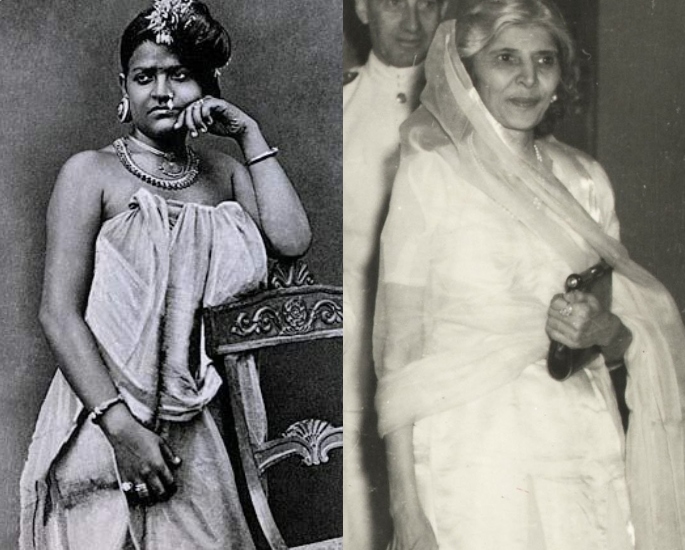
Pakistani fashion has significantly always been known to possess a sense of elegance, but does elegance mean modesty?
British Colonialism led to Pakistani women wearing more sarees and fewer salwar kameezs, with the former viewed as less modest and more revealing.
Although the Pakistani population experienced a similar journey through fashion as India, its independence from the UK in 1947 was the start of its own identity.
Although salwar kameezs and saris continued their formidability across communities, leading Pakistani women such as Fatima Jinnah began to influence women’s fashion.
Wide-legged pants accompanied by a kurti and dupatta became a unified symbol of Pakistani women.
However, in the 50s, some women held on to British ideologies and wore sleeveless saris, on a regular basis.
In the 60s, as fashion across the world began a riveting evolution, Pakistani women started to wear tight leggings under salwar kameezs. A trend that continues for many British Pakistani girls in the modern-day.
Witnessing the more revealing and ‘freedom’ fashion of the west, Pakistani women started idolising a ‘high-society’ lifestyle, with their outfits being the main symbol of that.
Saris with the integration of glamourous gowns, patterned dresses and minimal vests became the cultural identity for many women.
As flared jeans, chunky jewellery and floral tops took over in the 70s, Pakistan began revolutionising its stance on fashion.
The national outfit of Pakistan, the salwar kameez, was beginning to lose its prominence during British colonialism as it was deemed to be an outfit for the poor.
However, in the 80s, fashion mogul Tanweer Jamshed introduced a ready-made salwar kameez labelled ‘Teejays‘. Pakistans first ready-to-wear western institution.
Stylish and innovative, Tanweer’s western modifications on a traditional ensemble meant his designs were sought after for years, especially by the youth.
It was this demand from the youth that transcended Tanweer’s vision in the 2000s.
Experimenting with varying lengths, fabrics and cuts, models such as Vaneeza Ahmed and Aaminah Haq showed off garments that revealed more shoulder, chest and necklines.
It was this confident and unapologetic aura that lured the younger Pakistani women into wearing less traditional clothing, even though the older generation still dressed that way.
Was this the beginning of Pakistani fashions loosening grip on modesty?
Bangladeshi Fashion

Notably, Bengali fashion has been highly influenced by the countries and cultures surrounding it.
Prior to the 1850s, Bangladeshi men and women dressed in a very revealing manner, wearing only a single piece of clothing draped around them.
It wasn’t until British colonialism, that this changed and women began to wear minimalistic blouses underneath their saris to cover up.
Inspired by Parsi and Gujrati women, the sari began to be the staple of many Bangladeshi women. Especially once social reformer Jnanadanandini Tagore popularised it.
Interestingly, women began modernising the way they wore the sari.
Using stockings, bodices and petticoats, women personalised the fit of their saris to align with new ideologies.
Moving on, the influx of modest European inspiration can be highlighted in the 1890s. Bangladeshi women wore lace mantillas over their heads. In a similar manner to Spanish women and the upper British class.
Bangladesh, like much of the world, also experienced the ‘Roaring 20s’ in 1920. A fun, colourful, and exciting period.
Many of the upper-class and richer Bangladeshi women began to wear sleeveless blouses and colourfully electric sarees that amplified their status.
In the years to follow, big hoop earrings, psychedelic prints, miniskirts and flamboyant hairstyles ignited the daring nature of Bangladeshi women and resulted in a rollercoaster of fashion trends.
Saris are still worn across Bengali culture, but the style in which they’re worn has changed. They’re now worn in a more stylish, fitted and trendy manner.
From 2000 onwards, the fusion of traditional Bangladeshi garments and western modifications became the perfect blend for women.
A Confusing Journey for British Asian Women
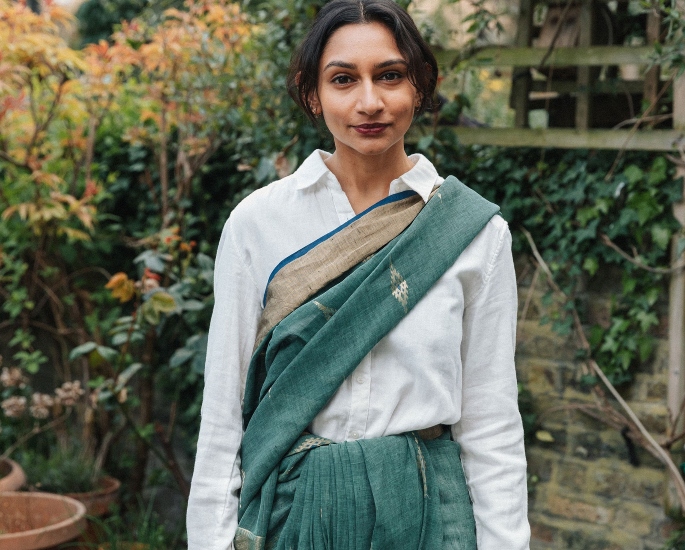
These are the trends of the Desi women living in South Asia, but are their British Asian counterparts making the same fashion choices as them?
Migration from South Asia began after WW2, with many Indians and Pakistani communities arriving in Britain in the 50s and 60s.
Racism was rife in the 60s for many Desi people and led many women to feel fearful of wearing their traditional clothing in public. This forced many to wear British clothing instead.
In the 2000s, many young and older Desis began to opt for the more fashionable choice of western clothing in Britain. Almost trying to force a British persona on their communities.
The South Asian population that immigrated already stood out because of the colour of their skin. So, many did not want to stick out even more with their clothing choice.
This was highlighted in Shivani Pandey Derrington’s 2014 study, where she carried out extensive research into the fashion space of South Asian women.
Interviewing Shobha, an artist from London, she expressed:
“I was brought up Indian in England and I kind of grew up thinking, wanting to be English. I wasn’t Indian at all.”
In addition, Jasminder, also from London stated:
“I suppose here, you do want to dress in some ways the same as they do, as people do here, yet you still want to keep your identity.”
In July 2020, university student Michaela Tranfield highlighted the normality of being ridiculed in school for dressing up in traditional clothing:
“When one of my friends went to music classes near our school in traditional Asian clothing… she always feared she would be spotted by kids from school and become the target of their jokes for the next few weeks.”
Emotionally adding:
“There is a very fine line between friendly teasing and clear racist insults that use a veil of humour to deflect from intentional prejudice.”
This exemplifies how ingrained stereotypes and prejudices are within British society.
‘Banter’ can draw upon the insecurities already felt by Desi women and force them to think western clothing will stop the discrimination.
Furthermore, many British Asians were raised with strict guidelines on how to dress for what occasion. Many British Asian girls wore uniforms to school and then came back home to change into kurtis or suits.
Desi women started to feel extremely vigilant of their clothing choices – ‘is it too much skin?’, ‘are my legs showing?’, ‘is this shirt too tight?’.
These feelings transcended to social events such as ‘daytimer raves’ which were predominant in the 90s.
A vast amount of British Asian girls would skip school, go to these daytime clubs and feel a sense of freedom because they had a period of time when they could avoid control.
Many British Asian girls would not be allowed to stay out with friends or go to parties so this was their way of achieving the same social pleasure.
Women would leave the house in their school uniform, with their club clothes in their bags. Excited by the prospect of bright lights, music and dancing, women also knew there was a high level of risk.
Many girls would hide behind people or walls whilst queuing so they would not get caught by a family member. If they did, they would suffer humiliation.
Accessories and make-up were also looked down upon because they represented a culture that was deemed inappropriate.
It unfairly highlighted to many young girls growing up in Britain that their worth is based on how they look or dress.
This highlighted the internal conflict of many South Asian women and the confusion on the ‘correct’ way to appear.
Bollywood’s Influence
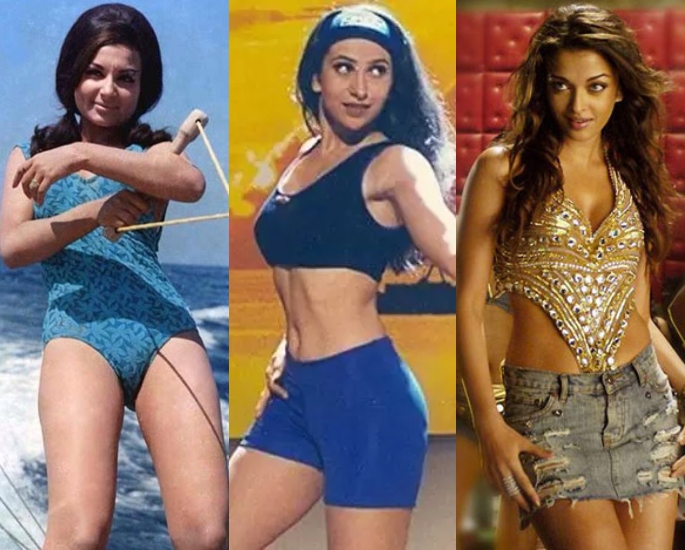
Bollywood has also had a part to play in this. With the large British Asian population, girls could watch their favourite actresses and many would want to imitate them.
Movies such as Dil Toh Pagal Hain (1997) and Dhoom 2 (2006)showcased actresses Karishma Kapoor and Ashwariya Rai Bachchan in sultry blouses, fitted vest tops and miniskirts.
Interestingly, even older movies such as An Evening In Paris (1967) and Rangeela (1995) presented actresses Sharmila Tagore and Urmila Matondkar in sassy and revealing swimsuits.
This depicts how historically instilled the western influence is on Bollywood, and the effect this would have on women.
Although movies like 2 States (2014)and Khoobsurat (2014)still portray the beauty of Desi clothing, the rate of modern outfits within Bollywood films is increasing. Seeing actresses in Desi clothes can be quite a rarity.
Analyst Sarah Deonarain revealed in her 2020 article for the Harvard Political Review that Bollywood can have an adverse effect on women and modesty:
“Indian women often use clothing to celebrate modernity and reject traditions dictating how they dress and behave.
“However, modern clothing is weaponised.”
She goes on to state how Bollywood plays its part in:
“Conveying the harmful notion that Indian women who wear modern, revealing clothing do so specifically for male attention.”
As the largest cinematic industry in the world, Bollywood has the right to entertain and exaggerate for dramatic purposes. However, given its enormity, it still needs to be aware of its social responsibility.
This raises the question; should Bollywood be doing more to remove the notion that ‘immodest’ clothing is a direct correlation to sex, lust and desire?
Immodesty or Modernity?
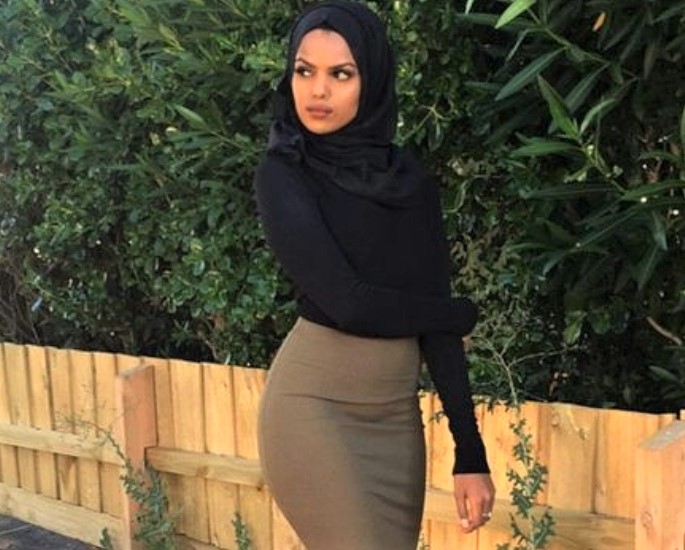
Although there are many elements that reveal why Desi women opt for a less traditional look, many Desi families are becoming accepting of clothing that is not classed as modest.
This makes it easier for young Desi women to dress as they wish. Without fear of backlash that perhaps the previous generations may have to put up with.
More communities, specifically the elder South Asian generations, are realising that cultural clothing is not as lost as it once seemed.
High Desi populated UK cities like Bradford, Leicester and Birmingham still showcase the colourful and rich ‘modest’ clothing on a daily basis.
Faiza* from Lancashire says:
“My parents are pretty chill about how I dress.
“I can’t say the same thing about my extended family. I can tell my clothing choices disappoint them.”
However, this disappointing feeling which was once feared does not hold the same weight amongst South Asian families.
Accepting the Modest Look
Furthermore, South Asian clothing has not entirely abandoned the element of modesty. Dupattas (shawl) are still worn and have even been fused with western clothing for a modern ensemble.
In addition, there are many Desi women who associate modest clothing with faith. For this reason, many Desi women may still choose to wear modest clothing.
Modesty can be very empowering and it emphasises the idea of ‘feeling confident, without showing skin’.
Umayya* from Bradford said:
“It’s empowering. You can choose who can see your body and who can’t.”
In fact, a 2019 article by Brooke Meredith described immodesty as ‘not feminism‘ and modesty on the other hand:
“Is about boundaries, personal dignity, class, and the treasuring of oneself.”
However, there are other reasons why many may opt for a more modest look. Sara, a financial advisor from Manchester passionately reveals:
“I feel as though I have to dress modestly to keep myself safe.
“I work in such a male-oriented environment, dressing in a revealing manner makes me uncomfortable, and I feel anxious.
“It’s easy to get sexualised, especially if you’re a woman. I do this to prevent anything from happening.”
Jasmine* from Erdington said:
“I’ve started wearing baggy joggers when I go out so that people don’t look at me.”
Perhaps the choice to dress modestly is one that many women make in a world where they do not feel safe dressing as they may really wish to.
Would they dress the same if the world was a safer place for women?
Celebrity Influence
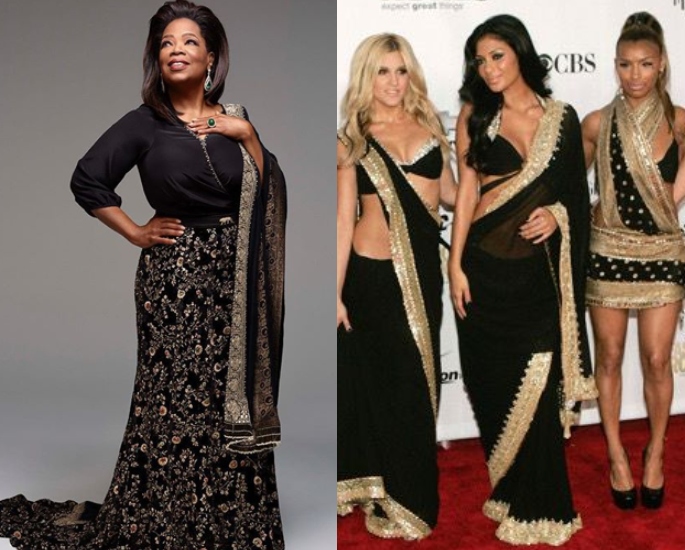
Moreover, it is becoming increasingly common to see more people from the west in Desi clothing, especially celebrities.
For example, Selena Gomez was seen wearing a sultry red Indian dress and bindi whilst performing her hit ‘Come And Get It’ at the MTV Movie and TV awards in 2013.
Alongside her are enormous superstars such as Beyonce, Lady Gaga, and Oprah Winfrey who have all donned gorgeous traditional wear.
The following of these megastars means the outreach their outfits received was off the scale.
However, some instances draw questions to whether celebrities are culturally appropriating or simply recognising the beauty in Desi clothing.
Like when the American girl group Pussycat Dolls donned all-black saris at the 2008 ‘Fashion Rocks’ concert.
Member Melody Thornton modified the sari to fit like a short dress. Whilst others had shown some extreme naval cleavage, making the sari blouses look like bras.
The age of modern social media has also contributed to this, with more British South Asian influencers like Erim Kaur and Kaushal beauty, opting for a more revealing look.
In turn, is this influencing Desi women towards a more immodest look?
There is no doubt that social media influencers are impressionable on many. Perhaps the increasing population of Desi social media influencers is emphasising the rate of change within fashion.
Although fashion has drastically changed from pieces of fabric, there is an argument that Desi fashion is both modest and immodest.
However, is that necessarily a bad thing? For years, modesty has been the focal point of South Asian garments but fashion, just like the world, evolves.
Many still wear modest clothing and celebrate it, even today, but this does not mean that all Desi women will opt for a modest look.
For many, they are concerned that Desi fashion may modernise too drastically and lose its cultural identity. However, that will only become clearer over time.


